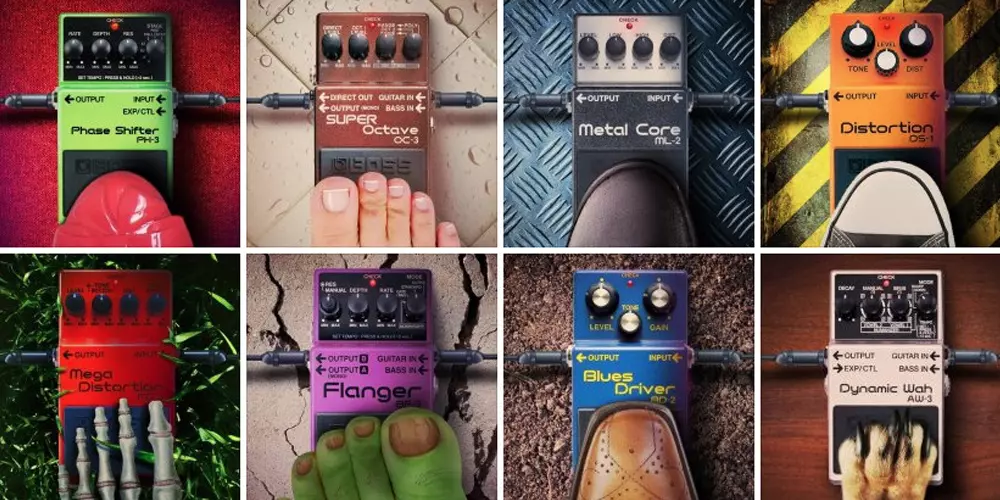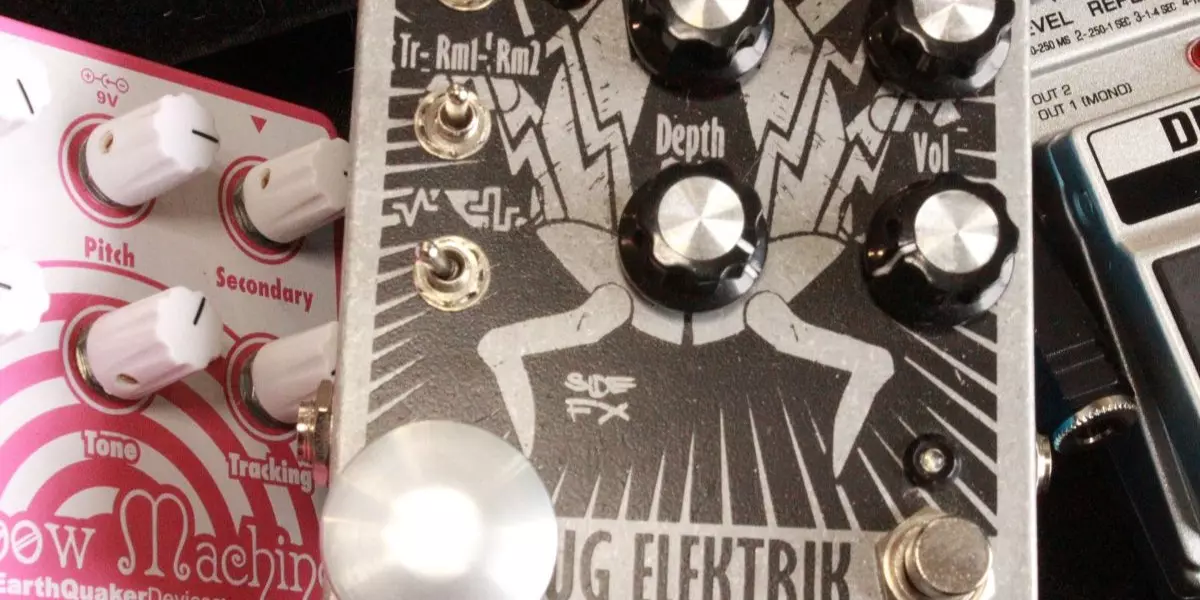Guitar Effects 101

Everybody likes gadgets, and guitarists are no different.
What starts as a quest for the perfect lifelong guitar might well end in an impressive collection. You might even buy yourself several different amps over your playing career.
Arguably, the most fun you can have, though, is experimenting with the multitude of those fun, coloured effects pedals.
If you’ve listened to any modern recording from the 1950s to present day, you have no doubt heard an effect used on a guitar. Guitar effects began with early amplifier manufacturers incorporating built-in enhancements such as reverb, vibrato, and tremolo, into their flagship model designs.

Artists increasingly began to use these effects to create some of the most memorable soundscapes of their time, from the reverb soaked sounds of “Apache” by The Shadows, the pulsing tremolo of “Rebel Rouser” by Duane Eddy, to the psychedelically soaked vibrato of “Lucy in the Sky with Diamonds”, by … oh, some famous Brits. The early 1960’s saw the emergence of portable standalone versions of these effects, and the concept of effects pedals was born.
This article will explore the main types of pedal effects, their musical purpose and give you some basic insight in order to determine where you should start on your tone quest.
GAIN EFFECTS
Do you have an amp that’s just not singing like it should? Do you need more sustain, grit, aggression, or are you simply looking for a full on, face melting sound? If you answered yes to any of these questions, then you’re likely in the market for a gain pedal. From subtle simulated tube overdrive, to metallic saturation, these pedals are sure to make your amp “go to eleven.”
Fuzz: Designed as the first floor effects unit, fuzz is widely considered the grandfather of gain. This effect was originally achieved by overdriving tube amplifiers until they sounded like they were about to explode, or alternatively, players would sometimes even slash their speakers cones to create that signature tone. Thankfully, with the affordability of effects pedals, users wanting to achieve this sound can now do so without risking damage to their amp. Fuzz is often used to add a chunky, thick, harmonically rich layer on top of lead guitar lines, and can be heard on songs such as “Satisfaction” by The Rolling Stones, “Foxy Lady” by Jimi Hendrix and “Howlin’ for You” by The Black Keys. Fuzz is of a simple design and usually consists of only Gain and Volume knobs, which allow the user to dial in the amount of effected tone.
FUZZ PEDAL PICKS:
- Electro-Harmonix Big Muff
- Dunlop Fuzzface (FFM3)
- RAT Distortion Pedal
Overdrive: Overdrive is one of the most common effects a guitarist might add to his or her arsenal. Think about that sweet tone that your tube amp achieves when it’s just on the cusp of breakup, when the amp seems to breathe new life and gets that creamy sustain. This is called natural overdrive. Unfortunately, not everyone is in a position to turn an amp up loud enough to get this effect, thus the overdrive pedal. Usually these are used to add richness to rhythm guitar passages and give you that biting lead tone on your solos. Other applications for this pedal are using it as a boost to take your already overdriven amp to the next level. Think Stevie Ray Vaughn’s signature barking blues.
OVERDRIVE PEDAL PICKS:
- Ibanez TS9 Tube Screamer
- Boss BD-2 Blues Driver
Distortion: Simply put, these pedals are meant to take your guitar tone from plain to insane! A staple in modern rock, distortion is an effect that positions itself, gain structure wise, somewhere between overdrive and fuzz. Distortion is the sound of your amp surpassing the natural overdrive stage to a point where it reaches a higher level of saturation, thickness and crunch. There are many distortion pedals available, some marketed as having genre specific sounds, and others which are designed to emulate the specific tones of classic amplifiers of both yesterday and today. Classic examples of distortion can be heard on “Smells Like Teen Spirit” by Nirvana, “Back in Black” by AC/DC and “Bark at the Moon” by Ozzy Osbourne. For those ready to rock, you’ll want this sound!
DISTORTION PEDAL PICKS:
- Boss DS1
- MXR M-75
- Mesa Boogie Throttle Box
DYNAMIC EFFECTS
Compressor: Long considered the secret weapon of the Nashville session player, compression is called a dynamic effect because it alters the volume or output of your amplifier/guitar combo in some way. The basic function of a compressor is that it makes louder sounds quieter and quieter sounds louder, all while increasing overall sustain, thus enabling you to have total control over the output of your instrument. Ever wonder how monster players like Mark Knopfler or Brent Mason achieve that bell-like chime and amazing articulation? The answer is lots practice and a great floor compressor!
COMPRESSOR PEDAL PICKS:
FILTER EFFECTS
Wah Wah: Introduced shortly after the first fuzz pedal, the wah is a great example of a classic floor effects unit. Funk, R&B, Disco, Metal, Blues and Rock all make great use of this effect, thus rendering it one of the most universally usable effects without genre limitation. This pedal is designed to have the user operate it by rocking his or her foot back and forth across the treadle, which controls an internal pot similar to the tone pot in your electric guitar. The sound that is created by traveling back and forth through a wide frequency spectrum is called “wah wah” and sounds similar to human vocalization. Listen to “Voodoo Child” by Jimi Hendrix or the solo section in “We Will Rock You” by Queen, and the effect will be instantly recognizable.
WAH PEDAL PICKS:
- Dunlop Original Crybaby
- Vox V845 Wah
- Fulltone Clyde Deluxe Wah
MODULATION EFFECTS
Chorus/Phaser/Flanger:
These modulation effects are all variations of one another, so let’s find out what makes them different. A modulated effect is essentially an audio signal that is affected by adding a secondary audio source into the signal path to create an unusual sounding result.
Chorus, often used with a clean guitar tone as its base, combines your original signal with an ever so slightly detuned secondary reproduction of that same signal to widen or plump up the resulting tone. Some people describe this as a lush, dreamy, shimmering, or even watery sound. Widely popular, especially in the 1980’s, this effect can be heard on many recordings from The Police and Prince.
CHORUS PEDAL PICKS:
- Boss CE-5
- T.C. Corona Chorus
- MXR M234 Analog Chorus
Phaser, also known as a phase shifter, employs a technology that allows for the altering of the phase of one portion of your guitar signal. Essentially what this means is that the pedal is creating peaks and valleys in your audio path, which result in a swirly, sweeping, psychedelic sound. Check out
Van Halen’s, “Eruption” or “The Rover” by Led Zeppelin and you’ll hear prime examples.
PHASER PEDAL PICKS:
- MXR M101 - Phase 90
- Boss PH-3 Phase Shifter
- Electro-Harmonix Nano Smallstone
What the heck is a Flanger, and how do you even say that?! Flangers basically recreation an old studio trick when reel to reel tape was still the common medium. Originally this effect was achieved by pressing on one of the tape reels with the heel of your hand to slow it down slightly while the other continues to turn at its regular rate. The resulting effect gives you a sound similar to a jet taking off, or what we think a UFO would sound like flying overhead. This is a pretty whacky effect and is usually used sparingly, but can sometimes adds that extra something to an otherwise lacklustre track. Check out Van Halen’s, “Ain’t Talkin’ ‘Bout Love” or Heart’s “Barracuda” for fantastic examples.
FLANGER PEDAL PICKS:
- Boss BF3
- MXR M152 Micro Flanger
- T.C. Vortex Flanger
Tremolo: As one of the first ever effects designed for musical use, the tremolo has an amazing history and is responsible for the signature sounds of many classic riffs over the history of modern music. Tremolo can best be described as the rapid variation in volume of your signal. The rate at which this happens can be controlled by the user using the rate knob on the pedal of his or her choosing. If this is still unclear to you, think about your guitar signal cutting in and out but in a gloriously musical fashion. Check out “Gimme Shelter” by The Rolling Stones or “Run Through The Jungle” by Creedence Clearwater Revival for some of the most legendary examples.
TREMOLO PEDAL PICKS:
TIME BASED EFFECTS
Delay: Delay is a common effect that most guitarists will use at some point in their playing career. Delay is a wonderful tool for adding soaring sweetness to lead lines and lush, dreamy swells to rhythm passages. Like tremolo, it can be controlled by a rate knob which allows you to create short delay times for chicken pickin’ country or rockabilly, or longer delay times often used in rock and heavy metal solos. Check out some great examples such as “Where the Streets Have No Name” by U2, or the solo section from “Time” by Pink Floyd.
DELAY PEDAL PICKS:
- MXR M169 Carbon Copy
- Boss DD-7
- T.C. Electronic Flashback
Reverb: Reverb is probably the most universally used and appreciated effect in the guitarist’s arsenal. A reverb pedal can duplicate the sound of playing in a large room, complete with ambience and reflections, even if you are just jamming at home with headphones on. If you’ve ever plugged straight into an amp and thought to yourself that it sounded great but was just missing a little something, you’ve probably forgotten to turn on the reverb. A pedal effect without genre limitations, you’ll hear great examples in the intro to “Cliffs of Dover” by Eric Johnson, as well as “Wicked Game” by Chris Isaak.
REVERB PEDAL PICKS:
- T.C. Hall of Fame Reverb
- Electro-Harmonix Holy Grail
Looper: The newest, hottest thing, loopers have taken the market by storm in the last couple of years. Do you wish you had a band to jam with? Does that thought of recording your ideas to a computer sound terrifying or too complicated? If the answer is yes, then you’ll likely benefit from one of the easy to use loop pedals currently on the market. A loop pedal allows you to record your ideas on the fly and play them back while overdubbing subsequent ideas over top of the original, thus giving you the ultimate layering tool. Whether you’d like to just jam on an idea at home, make backing tracks for your one person act, or create the illusion of more than one player in a single guitarist band, a loop pedal will allow you to accomplish all of this.
LOOPER PEDAL PICKS:
- T.C. DITTO Looper
- Boss RC-3LS Loop Station
- Digitech JamMan Solo XT
Here we’ve only just scratched the surface, there is much more to explore on your personal tone journey. It may sound like a daunting task to narrow down your choices, but rest assured, the world of effects can provide some of greatest fun you’ll ever have with your instrument.
Andrew Waite is the assistant manager at the Halifax Long & McQuade location. He has toured across Canada several times performing, and has a diploma in Entertainment/Artist Management.


















